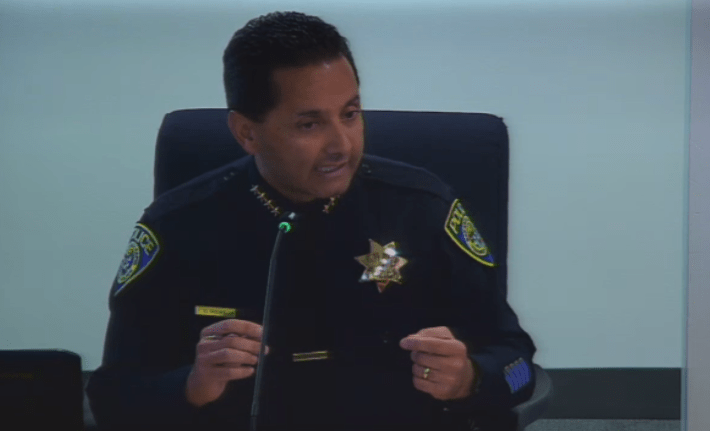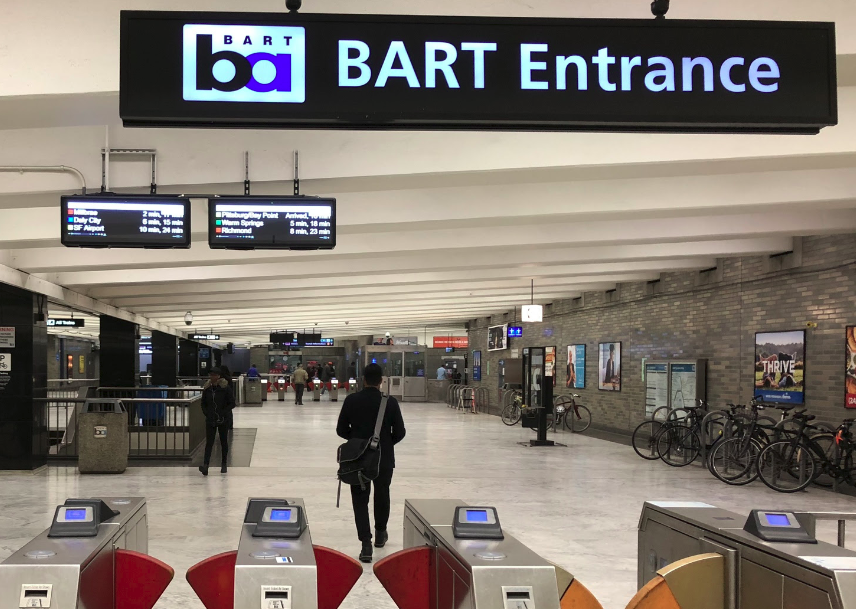Note: GJEL Accident Attorneys regularly sponsors coverage on Streetsblog San Francisco and Streetsblog California. Unless noted in the story, GJEL Accident Attorneys is not consulted for the content or editorial direction of the sponsored content.
This morning at its regularly scheduled meeting, the BART Board of Directors heard a list of proposals from the agency's General Manager, Grace Crunican, on short-and-medium terms steps to beef up security on the mass-transit system. Some of these she can do on her own authority, and are already in motion under her "BART Safety and Security Action Plan," including temporarily increasing police patrols through overtime, a safety educational campaign, and trying to get more riders on the BART Watch App, a phone app that lets people report crimes on BART via text. "Our BART Watch app lets the public communicate, safely, their concerns hundreds of times weekly. We need to market the BART Watch app to other passengers," said Crunican.
As of Monday, all BART police officers have been required to work six days a week, and all sick days will require medical documentation. "I didn’t take this decision lightly," said BART police chief Carlos Rojas, who commands just over 200 officers. "I am concerned for their health and wellness, but I feel it’s something we needed to do to affirm our commitment to safety. We formulated a deployment plan that focuses on visibility and presence on platforms, station, and trains."

They're also deploying "BART Employee Station Teams" (or 'BEST' teams for short) that consist of BART's office and administrative staff workers who can volunteer to receive some basic safety training and would become "eyes and ears" for the agency. These teams will patrol stations at times of high alert--if there was a bombing of a transit system somewhere in another city, for example--and phone in anything that requires a police response. They would wear BART vests and be deployed in "any situation where the general manager feels it’s important to provide that extra visibility and assurance to our riders," said Assistant General Manager for Operations Paul Oversier.
Other proposals in the plan require BART Board approval and turned out to be quite contentious, both with the directors and members of the public. BART came under heavy criticism back in 2016 because many of the cameras in their rail cars were dummies. This was a factor in the agency failing to apprehend a suspect in a murder that took place under one of the dummy cameras back in January of 2016. BART has since installed cameras on all its rail cars, but it wants to take the camera system further. The proposal is to spend $15 million upgrading remaining analog cameras to digital ones and expanding the system to fill any holes in coverage. "Our coverage is not uniform," said Oversier, adding that many areas in station parking lots are not covered. In addition, he explained, many of the cameras look down stairways or concrete hallways, and it's impossible to tell exactly where the camera is located to direct emergency services to the right spot.
That's why, in addition to going all-digital, the agency wants to roll out a Physical Security Information Management (PSIM) system. That's software that provides a map of each camera position and shows security personnel nearby cameras, to help them get other views on a pending problem. "PSIM lets them use a dynamic map to select another camera position and provide information to people on the ground," said Travis Engstrom, BART's assistant chief information officer. It also points out assets, such as police and fire units, that are available nearby to dispatch. "It's a force multiplier," he added, that "helps us sharpen and identify events, large crowds, motion alerts, equipment tampering--it improves effectiveness."
BART staffers also reminded the directors that cameras and the BART app helped the police track down suspects in the four recent, high-profile acts of violence on BART, including helping them catch Nia Wilson's murderer. Staff estimates it would cost around $4 million to upgrade cameras and add the software (the PSIM system is already undergoing testing at Lake Merritt station). Engstrom said, if approved, it would take about a year to roll out the PSIM system throughout BART.
Staff also wants to accelerate an already underway security hardening of BART by raising the height of railings around BART entrances to make them harder to jump. They also want to replace fare gates. "It’s not 1972 anymore and we need gates that provide a greater level of security than what we have today," said Oversier, who estimates replacing all the fare gates would cost "between $150 to $200 million."
Crunican also wants to ban panhandling in paid areas of BART, add call boxes on station platforms, and add another team of fare inspectors.
The proposals were met with little support, and quite a bit of hostility, from the public during the comments period.
"The answer is not a rushed surveillance proposal, that poses a unique threat to people of color, immigrants, and activists," said Mike Chase with the ACLU of Northern California. "The board should reject suggestions of one board member to add facial recognition."
Facial recognition wasn't actually in the proposals staff made to the board, but Nick Josefowitz, a BART Board director for San Francisco, discussed that possibility in a television interview on ABC's local affiliate. Many members of the public who spoke were concerned that facial recognition software could later be applied to BART's surveillance video if, for example, it were one day acquired by the Feds. "It's Orwellian. Happy to hear that’s not being proposed today, but please don’t approve any surveillance systems until you first get your privacy and transparency policy up and running," said another of the public speakers.
"There are some aspects of video analytics that can be employed, but I want to see a privacy policy in place," said Board President Robert Raburn.
In contrast, director Joel Keller was concerned about the number of emails he's received from people in his district who say, in light of the recent murders, they will no longer ride BART. He pointed out that inside a public transit system there aren't the same legal protections; for example, there's no privacy protection when one boards a plane. "You're asking people to have privacy in an environment that is not protected by privacy," he said in support of PSIM.
Director Josefowitz added that many of BART's problems with crime and homelessness are beyond the agency's ability, or charter, to handle. "BART isn’t going to be the social services department for the entire Bay Area--we need to convene, from the communities that BART serves, a coordinated inter-agency regional approach to assure that BART remains safe and vibrant."
He cited BART's collaboration with 'Hunters Point Family' to hire elevator attendants as an example to build on of how the transit agency can work with community groups to make the system safer and more secure. "It’s time to take this approach system-wide and look how we can address the underlying problems."
"If we're going to convene with community leaders, that's going to take months, if not years," replied Director Keller. "What are we going to do tomorrow to ensure the safety of our riders? We are failing them... If we don’t provide immediate steps, our riders will think we’re incompetent and morons."
Keller and other Board Members asked to hold a second meeting, in the evening, in a suburban location, to hear from different groups of constituent than the morning crowd that came to the agency's downtown Oakland headquarters. "We haven’t heard from the frightened riders who are reluctant to use our system."
The Board eventually decided to convene that second meeting and delay voting on many of Crunican's proposals until then. Details on the meeting will be posted in the Board of Directors section of bart.gov.
In addition, they instructed staff to complete a digital privacy policy within 30 days--a project that is already in motion but has dragged on--so that they could vote on the cameras at the September 13 regular board meeting. In the meantime, they voted, 6-3, to have her prepare contracts and bring back for board action expanding BART’s digital camera network in stations, parking lots, and garages and to installing platform emergency call boxes.
The proposed Safety and Security Plan will cost an estimated $25 million in capital costs and $3 million in ongoing costs. The Board also instructed staff to work on more community partnerships, like the elevator attendant program, to help make the system safer and more secure.







